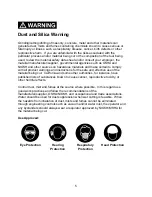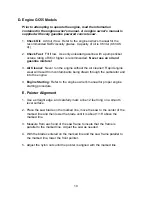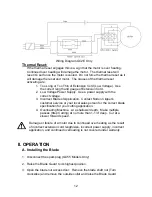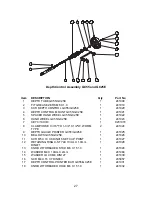
17
surface. When the blade meets the concrete surface at a 90° angle
(perpendicular) less side drag is created on the blade. When the blade is
not perpendicular side drag is create that will cause the concrete to chip or
spall.
3. Blade that is designed for green concrete cutting. The GMAX blade has
some unique features that make it an outstanding blade for green concrete
cutting such as:
a) Anchor Slot Core Technology that reduces vibrations in the blade.
Excessive vibrations will cause the blade to flutter or bend from side to
side which will damage the concrete surface and cause the blade to
wear out prematurely.
b) Thicker core that resist flexing and bending. Thin core blades bend
due to excessive pressure during cutting and from over heating. When
blade bends and flexes the concrete and blade will be damaged.
c) Optimized bond and diamond for fast green concrete cutting. The
improper bond will not cut green concrete properly.
When to Start Green Concrete Cutting
Timing is the most important aspect of cutting green concrete. The time that
the operator can start cutting will vary depending on the key factors listed
above. For example if the concrete has a high water to cement ratio or the
day is cooler then more time is required for the concrete to properly set up
and hold the aggregate in place. Typically we are finding that starting around
5 to 6 hours after finishing good results can be obtain. We find in our testing
that at 16 hours in gives the best results. These times to start are assuming
that the concrete has set up long enough to hold the aggregate in place.
Green Concrete Cutting Trouble Shooting
Spalling or Chipping On Both Sides of Cut:
1.
Wait
at least 1 to 2 more hours before cutting. The very good cut
appearance is achieved at 5 to 6 hours after finishing complete. The best
cut appearance occurs when the concrete has set up enough for the
aggregate to be held in place which may take up to 16 hours. The actual
time to begin cutting will depend on many factors such as: concrete
mixture (PSI, concrete type, sand type and amount, and other materials,
water to cement ratio – more water the longer the set up), aggregate size
and type, concrete additives – some speed up while others slow down the
set up time, environmental factors (Sun, wind, rain, temperature), concrete
temperature (Cooler the concrete the longer the set up time).
Summary of Contents for GC25E
Page 39: ...39 NOTES...
















































